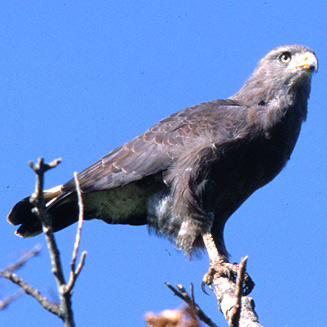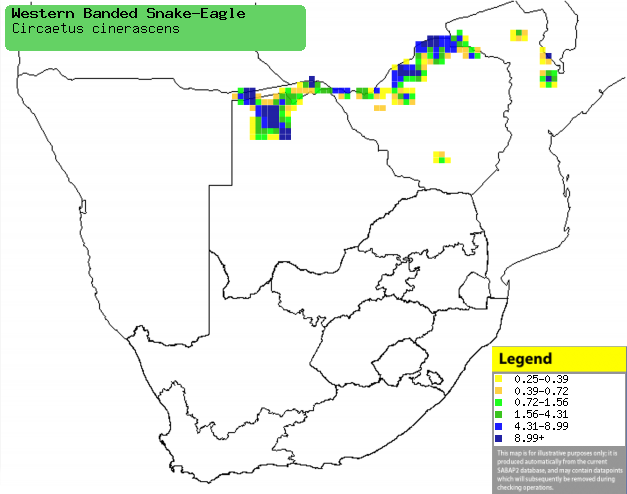|
Circaetus cinerascens (Western
banded snake-eagle)
Enkelbandslangarend [Afrikaans]; Kleine grijze slangenarend
[Dutch]; Circaète cendré [French]; Band-Schlangenadler [German];
Águia-cobreira-de-cauda-branca [Portuguese]
Life
> Eukaryotes >
Opisthokonta
> Metazoa (animals) >
Bilateria >
Deuterostomia > Chordata >
Craniata > Vertebrata (vertebrates) > Gnathostomata (jawed
vertebrates) > Teleostomi (teleost fish) > Osteichthyes (bony fish) > Class:
Sarcopterygii (lobe-finned
fish) > Stegocephalia (terrestrial
vertebrates) > Tetrapoda
(four-legged vertebrates) > Reptiliomorpha > Amniota >
Reptilia (reptiles) >
Romeriida > Diapsida > Archosauromorpha > Archosauria >
Dinosauria
(dinosaurs) > Saurischia > Theropoda (bipedal predatory dinosaurs) >
Coelurosauria > Maniraptora > Aves
(birds) > Order: Falconiformes
> Family: Accipitridae
> Genus: Circaetus
 |
 |
|
Western banded snake-eagle, Poli, Cameroon. [photo
Nigel Voaden
©] |
Immature Black-chested snake-eagle, Gambia. [photo
Bill Clark ©] |
Distribution and habitat
Occurs in sub-Saharan Africa,
largely absent from the lowland forests of the DRC and other west African
countries In southern Africa it is uncommon in
northern Botswana, the Caprivi Strip (Namibia), northern Zimbabwe and northern
Mozambique, generally favouring riverine forest and woodland, such as tall
Mopane (Colosphermum mopane) woodland in the Zambezi River valley; it occasionally hunts in adjacent open habitats.
|
 |
|
Distribution of Western-banded snake-eagle in southern Africa,
based on statistical smoothing of the records from first SA Bird Atlas
Project (©
Animal Demography unit, University of
Cape Town; smoothing by Birgit Erni and Francesca Little). Colours range
from dark blue (most common) through to yellow (least common). |
Movements and migrations
Probably sedentary in southern Africa, although
it is scarce in summer in Zimbabwe.
Food
It mainly eats snakes (especially arboreal ones), doing
most of its hunting from a perch, where it stays immobile for hours while searching for
prey. Once it spots something, it glides to the ground or tree canopy and plucks the
animal up, before returning its perch to feed. The following food items have been recorded
in its diet:
- Vertebrates
- reptiles
- snakes
- lizards
- newly hatched tortoises
- frogs
- small rodents
- fish
- Invertebrates
Breeding
Threats
Not threatened globally, although degradation of riparian
forest, by humans and African elephants (Loxodonta
africana), seems to have decreased its population in Zimbabwe and Namibia.
References
-
Hockey PAR, Dean WRJ and Ryan PG 2005. Roberts
- Birds of southern Africa, VIIth ed. The Trustees of the John Voelcker
Bird Book Fund, Cape Town.
|
